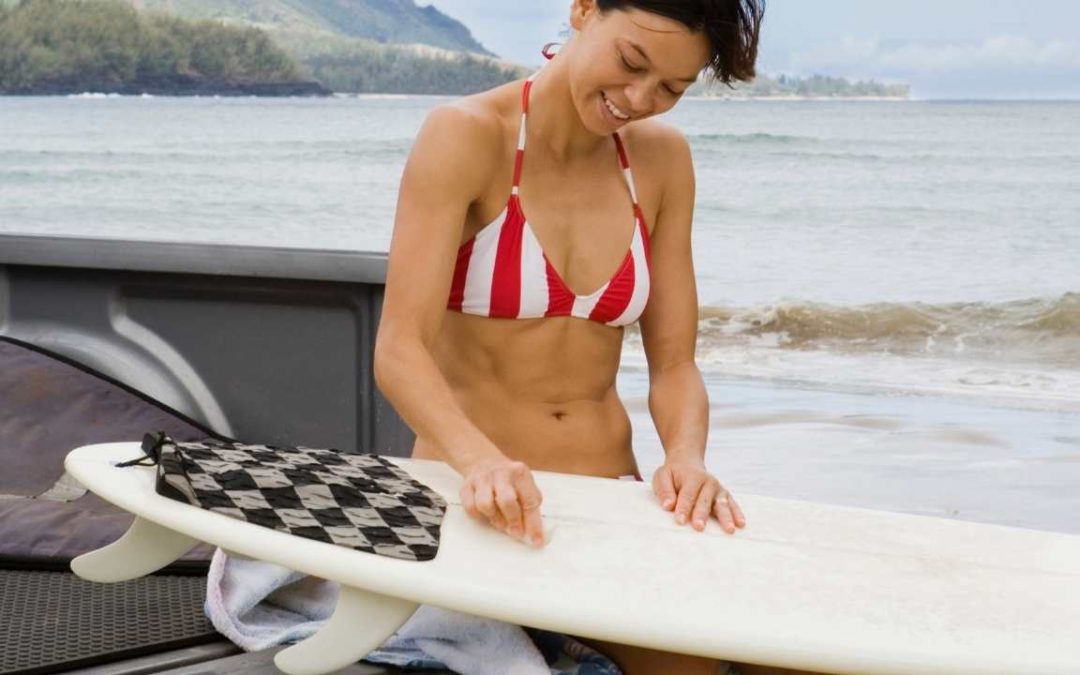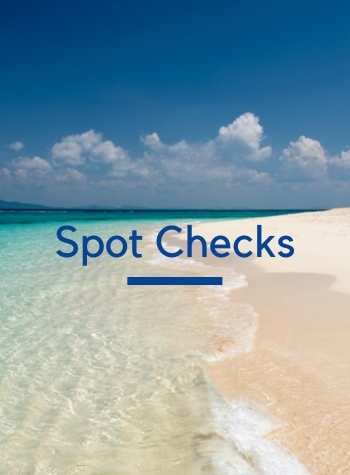I remember my first surfboard like it was yesterday. It was a 7ʻ10” San Miguel, used but completely clean on the deck, with no wax. I knew nothing about surfboards at this point, so the very next day I paddled it out and had a heck of a time.
I kept slipping and sliding. I couldnʻt figure out why it was so hard just to paddle, let alone trying to popup. Luckily a salty old local came over and told me my surfboard had no wax on it.
Surfers apply wax to the deck of their surfboards to create traction so that your body and feet do not slip off the board while riding it. Some surfers sometimes use wax to temporarily fill in dings as well (which I would not advise), but it is mostly used for traction.
Wax was developed pretty early on in surfingʻs history. Surfers tried everything. Beeswax. Adding sandpaper or grit to resin. You name it. Eventually, they settled on paraffin wax, only recently giving way to more natural wax ingredients.
If you’re looking to be an excellent surfer, you need to start by having a firm grip on the surfboard. One solution to this is waxing your board, and we’ll dive into all the details but let’s start from the basics.
Get A Grip On Your Surfing
Falling off your surfboard can cause serious problems, injuries, and mishaps. Without waxing your surfboard, itʻs almost impossible to stand up on one. Waxing your board will make your life easier by giving you that extra grip while surfing. Trust me on this!
You either apply wax to the deck of your surfboard or you use some sort of traction pad on the deck of your board to provide the same function.
Don’t get it wrong. It’s not the same wax as you apply on your car. This wax is specially made for surfing. Surf wax is very sticky. This stickiness helps surfers gain some grip with their feet as there’s no other way to hold on to the board.
There are tons of different types of wax out there, but they all pretty much do the same thing, itʻs just that some are better at it. But which ones are better at it? Youʻre in luck because Iʻve probably tried every wax out there looking for the perfect grip.
Which Wax Is Better?
| 1-10 | Sticky Bumps | Quick Humps | Famous | Matunas | Green Fix |
| Eco | 8 | 4 | 2 | 10 | 10 |
| Grip | 10 | 10 | 6 | 7 | 8 |
| Overall | 9 | 6 | 4 | 8 | 9 |
There was a time when 2 wax brands dominated the market, at least in CA, Sex Wax and Sticky Bumps. If you went into any surfshop at the time, these 2 brands were probably behind the case when you were checking out.
I always found Sticky Bumps to be the best. Sticky Bumps, when applied, created perfect little humps that provided peak traction. You can pick up your own bars on Amazon.
Sex wax kind of just seemed like it smeared on, not creating any bumps.
Thatʻs how things used to be. Today, things are so much different.
Sticky Bumps and Sex Wax are still around, except Sex Wax created a new formula they call “Quick Humps” that waxes a surfboard just as well as Sticky Bumps does.
The other mainstream wax brands include Mrs. Palmer, Famous Surf Wax, and Bubble Gum Wax. Iʻve tried all of them out at one point and found them all to perform pretty poorly. I would stay away from these brands.
What is pretty exciting these days is that there have been a few alternative wax brands coming to the market recently that perform remarkably well. But get this, theyʻre made from 100% natural ingredients.
Conventional surf wax is made out of paraffin, which is a petroleum based product that can be harmful to the ocean environment. Wax brands such as Matunas & Green Fix use 100% all natural ingredients in their wax formula.
I have tried these 2 wax brands before and have found them to apply to the surfboard very well. When done properly, the wax formed humps on the deck of the surfboard, providing more than enough traction for the average surf session.
Only thing I found different from these wax brands compared to Sticky Bumps or Sex Wax is that I had to reapply more often, before each session rather than after every few surf sessions.
If you are into protecting the environment, which we should be, then think about using one of these natural wax brands the next time you paddle out. Get yourself a couple bars of Matunas and make that shift today!
Wax Comes In Different Ratings
When you go to purchase wax, you may notice that they are rated for different types of conditions.
You have your base wax, which is applied first onto your surfboard as, you guessed it, your base layer of surf wax. It is harder than the other wax ratings, goes on quicker and provides a good solid base for your wax job.
On top of the base coat, you should apply a wax rated for the water temperature that you will be surfing in. There is Cold Water, Cool Water and Tropical Water.
You can use cold water wax in tropical conditions, but it may dissolve easier than if you used the wax with the proper rating, meaning you may have to apply more before you even finish with your first surf session.
Wax brands make it really easy for you to know which wax rating to buy. You can check for the temperature on the pack of each wax.
How to Apply the Wax To A Surfboard?
Applying wax to a surfboard is a ritual for some surfers. Theyʻll setup a little space, gather up all their supplies and ritually apply wax in a way that might be unique to only them.
It makes sense because if you donʻt rush this part, you can develop the most amazing set of wax humps on the deck of your surfboard that will keep your feet glued to your board even in the most harrowing of situations.
Hereʻs what I do to apply wax to a surfboard.
- Prepare Your Surfboard
Preparing your surfboard is one of the most important yet neglected steps of waxing your surfboard. Before you start applying a new layer of wax, you need to wipe off that old wax that you put on the last time, unless youʻre just topping off before paddling out.
- Put the board in the sun and let it melt naturally.
- Use the blunt side of a wax comb or an old credit card and get the bulk of the wax off. Learn more about how to use wax combs in this article.
- Take the board back into the shade and moisten an old rag with paint thinner and remove whatever wax is left remaining.
Or better yet, use The Pickle instead of paint thinner. Want to help the environment? The Pickle uses 100% recycled ingredients and contains no harsh chemicals. Best off all, it is amazing at removing left over wax on your surfboard.
- Apply the BaseCoat (Hard)
The process of applying wax to your surfboard typically consists of 2 layers, the basecoat and the topcoat.
The first layer of wax applied to a surfboard is the basecoat, which is usually made up of a harder mixture than the top coat.
I like to start on the deck going from wear my front foot and chest would lay on the surfboard down towards the tail. I apply the wax diagonally with a light, but firm touch. Once I go down the board diagonally one way, Iʻll come back up the board diagonally the other way.
Apply the basecoat until the deck of the board is sufficiently covered.
- Apply the TopCoat (Soft)
After applying the base coat, it’s time to put on the second or final coat. Again, there are plenty of options to choose the suitable wax for your second layer.
You can apply the second layer of wax in any pattern you like. Blocks, circles, and zig zags are some of my favorite ones, with circles being my favorite out of the 3.
Using the wax on edge just a little bit, Iʻll lightly apply it to the base coat in a circular fashion, eventually nice little bumps will begin to form. If you are patient enough, those bumps will turn into beautiful little humps that will provide ultimate traction.
A good wax job is well respected by other surfers, so be sure to do a good job. Who knows, you might get more waves.
- Word Of Warning
This should go without saying but Iʻve seen it done so here it goes. Wax is ONLY for the deck of a surfboard. It is not to be applied to the bottom of a surfboard.
The bottom of a surfboard is meant to be smooth so it can plane quickly through the water without friction. Remember, surf wax is not car wax. It does not polish, its only function is to provide traction.
If you have a soft top surfboard, you may be wondering if those are meant to be waxed as well. If thatʻs you, check out this post that dives into whether or not you should or shouldnʻt wax a soft top surfboard.
Wax Up And Go Have Fun
Itʻs time to wax your surfboard if you havenʻt already. I like to do it ahead of time before Iʻm even thinking of going for a surf. Find a little downtime at home and treat it like a meditation.
Learn the curves and shape of your board.
Imagine yourself surfing. All of the fun youʻre about to have.
It all starts with a solid foundation. The wax on your board. Without it you canʻt get up. So wax up and get on out there!
Thereʻs some surfing to be done!



